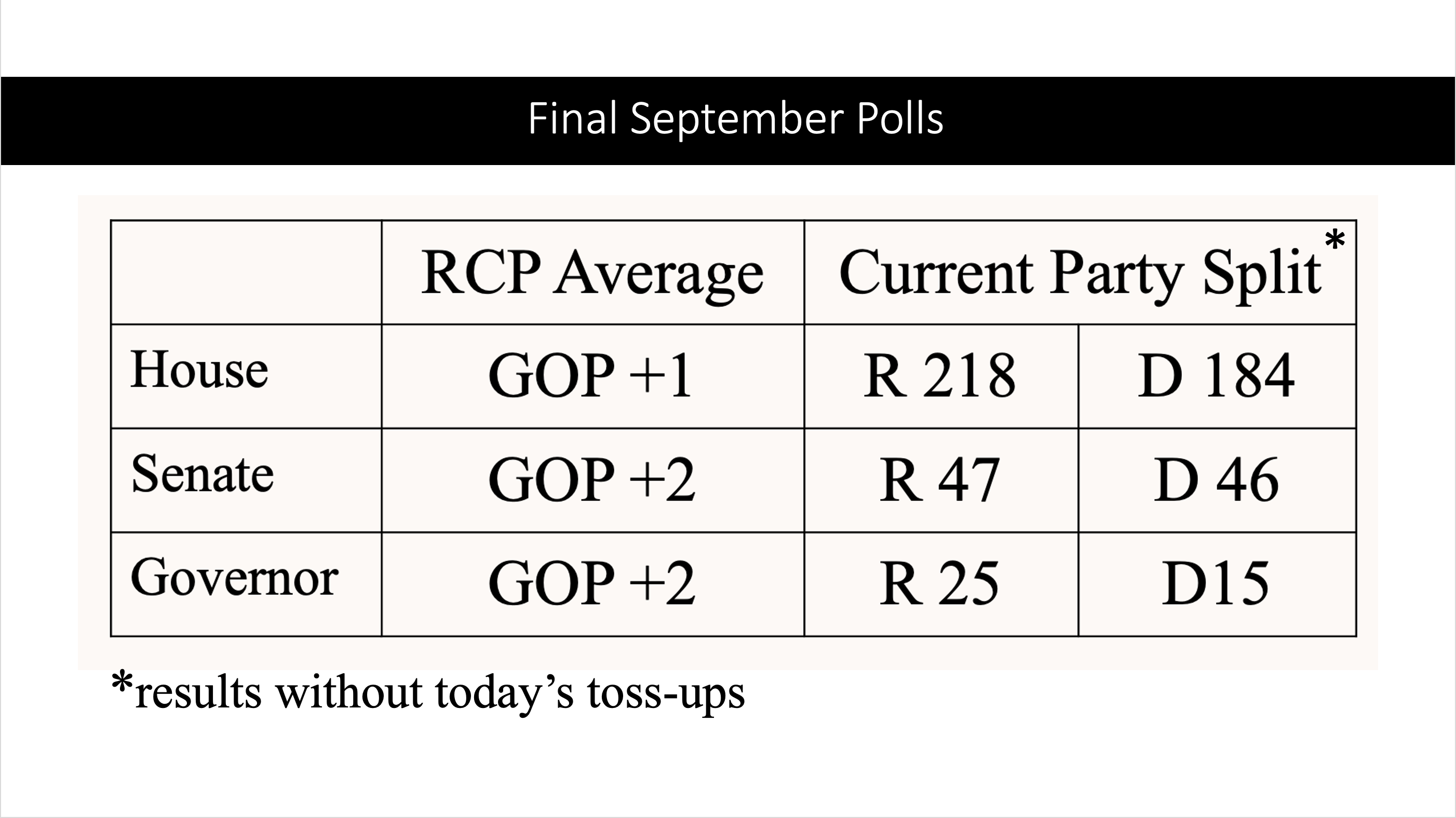Legacy media are all over a new ABC-Washington Post poll released last Sunday, because it found the GOP’s summer swoon had reversed and the odds of Democrats holding the House had dimmed. The poll’s generic House ballot had Republicans up 5 points, which aligns with Friday’s RCP average. What caused this shift? Three things that occurred in September.
Start with bad economic news: August jump in CPI, Fed rate hike, downward GDP revisions, upward inflation revisions, and 9% drop in stock indices. Add the poll’s “top voter issues” of the economy, education, inflation and crime – all favoring Republicans – and the political brilliance of Governor DeSantis (R-FL) flying illegal migrants to Martha’s vineyard, which pushed Democrat talking points (Trump, abortion and climate change) out of the headlines.
Five weeks out, most of the credible polls are trending Republican (see the RCP averages up top), so let’s unpack the GOP’s favorable odds of reclaiming the House, starting with Karl Rove’s prediction in the Wall Street Journal of 233 Republicans in the House after a “net gain of 20 seats” in November. Not exactly a red wave, but he reminded readers “the GOP got a head start in 2020 by picking up 14 House seats.”
Rove calls the 1-point GOP lead in the current Real Clear Politics average “misleading” because that is a “national generic ballot” and Democrat “voters are clumped together geographically.” In other words, national leads aren’t “enough in a competitive region” because a big Pelosi win in San Francisco doesn’t count any more than a narrow Jackson victory in rural Texas.
Because “the generic ballot in competitive congressional districts was 55% Republican, 34% Democratic among all voters, compared with 51% GOP, 46% Democratic with likely voters nationally,” Rove claims it’s “highly likely the GOP wins most of the competitive races and takes the House.”
The GOP is better aligned. “The problem for Democrats is that abortion and climate are less important to voters than pocketbook and safety concerns.” It mattered in 2016 – and today, when the economy and crime are important to more voters (61%) than abortion and climate change (35%). This is true, but Rove still observes “Democrats playing up expectations that they could keep the House (and) Republicans more reserved about their outlook.”
Former congressional chief of staff Athan Koutsiouroumbas corroborates Rove’s prediction by detailing how “competitive races” are actualizing in his own state of Pennsylvania. In recent analysis for Real Clear Politics, he found competitive and safe-GOP districts lean to Republican candidates, and noted that competitive House districts were in the exurbs and suburbs surrounding Philadelphia and Pittsburgh.
No surprise that Koutsiouroumbas projects a “GOP electoral landslide unlike any other” in Pennsylvania because of three facts; city voters are joining the GOP (by a 60-40 split in Pittsburgh and 10-point margin in Philadelphia), exurban and suburban voters are re-registering as Republicans (by a 2:1 margin over Democrats in Bucks and Butler counties), and GOP candidates lead by 21 points in “competitive” and 24 points in “safe Republican” districts.
If this shift is news to you, it’s because the press is obsessed with Pennsylvania’s close statewide races, and the pollsters are confused. Koutsiouroumbas found many voters “just now learning the identities of candidates” due to redistricting that “substantially changed the composition of suburban and exurban districts – in some instances, the change is greater than 50%.” Suffice it to note this trend exists in other battleground states.
Last month, legacy media outlets reported the likelihood of continued liberal bias in the polls (under-counted GOP) without hinting at the Democrats’ role in creating “shy” and “submerged” Republicans. The aforementioned ABC-Post poll is a textbook example of right-frightening bias. The question below was pulled from the actual survey:
The US Justice Department is currently investigating Donald Trump on issues including his fund raising, his handling of classified material and actions related to the storming of the Capitol last January. Do you think Trump should be charged with a crime in any of these matters?
That question – especially the “fund raising” segment – is a red flag for many Republicans. The poll is supposed to predict the mid-terms; therefore, any college-educated pollster should know better, especially after Biden’s silence while his constituents menaced Supreme Court justices, request for 87,000 more IRS agents, raid on Mar-a-Lago, and “Jim Crow 2.0” and “semi-fascism” characterizations of Republicans.
Still, despite the bias, the ABC-Post poll has Biden’s approval 14 points under water and the GOP leading 51-46 percent with “likely voters” on the generic House ballot. This aligns with the anti-Democrat mood that’s been building over the last four quarters (depicted in the RCP averages below).
| Q3 2021 | Q4 2021 | Q1 2022 | Q2 2022 | Q3 2022 | |
| Biden Approval | -3.7 | -8.9 | -8.8 | -15.3 | -10.4 |
| House Ballot | D +2 | R +3 | R +3 | R +3 | R +1 |
The trend is clear. Biden and his party are less popular now than one year ago – even after Democrats have bragged, investigated and scare-mongered at historic levels. Simple facts remain; a September reality check upon Biden’s economic happy talk, and a bunch of “election integrity laws” on the books in battleground states.
Anything, of course, can happen in an election (it’s why they’re called “upsets”), but expecting Nancy Pelosi to remain speaker is akin to expecting the S&P to recoup its 2022 losses by Election Day. That’s the House, so next week’s post will check in on the statewide races.
